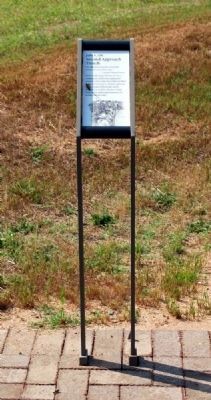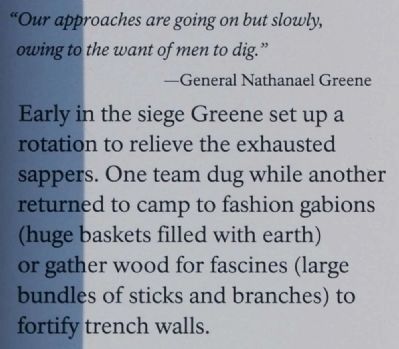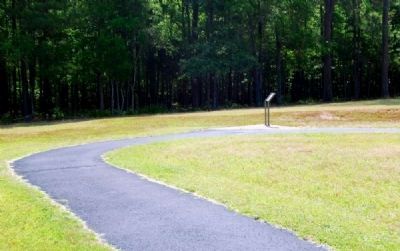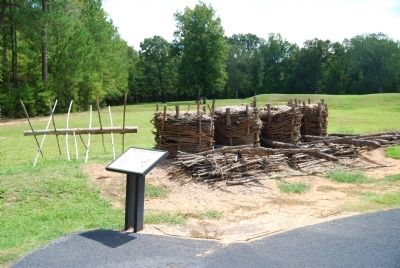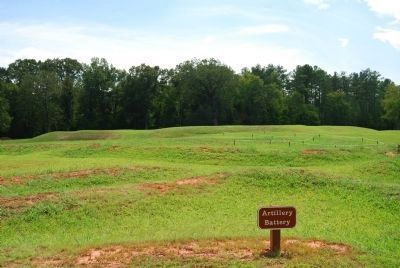Ninety Six in Greenwood County, South Carolina — The American South (South Atlantic)
Second Approach Trench
June 6, 1781
"Our approaches are going on but slowly owing to the want of men to dig."
General Nathanael Greene
Early in the siege Greene set up a rotation to relieve the exhausted sappers. One team dug while another returned to camp to fashion gabions (large baskets filled with earth) or gather wood for fascines (large bundles of sticks and branches) to fortify trench walls.
Erected 2009 by National Park Service.
Topics. This historical marker is listed in these topic lists: Colonial Era • Forts and Castles • Man-Made Features • War, US Revolutionary.
Location. 34° 8.811′ N, 82° 1.12′ W. Marker is in Ninety Six, South Carolina, in Greenwood County. Marker can be reached from South Cambridge Street. Marker is on the grounds of Ninety Six Historic Park battlefield. Touch for map. Marker is in this post office area: Ninety Six SC 29666, United States of America. Touch for directions.
Other nearby markers. At least 8 other markers are within walking distance of this marker. Second Parallel (here, next to this marker); Approach Trench (within shouting distance of this marker); The Rifle Tower (within shouting distance of this marker); The Artillery (within shouting distance of this marker); The Mine (within shouting distance of this marker); The Attack (about 300 feet away, measured in a direct line); The Forlorn Hope (about 300 feet away); Island Ford Road (about 300 feet away). Touch for a list and map of all markers in Ninety Six.
More about this marker. Marker shown in Photo 1 is the current version of the marker.
Also see . . .
1. Ninety Six National Historic Site (U.S. National Park Service). Here settlers struggled against the harsh backcountry to survive, Cherokee Indians hunted and fought to keep their land, two towns and a trading post were formed and abandoned to the elements, and two Revolutionary War battles that claimed over 100 lives took place here. (Submitted on September 8, 2008, by Brian Scott of Anderson, South Carolina.)
2. Nathanael Greene. Nathanael Greene (August 7, 1742 – June 19, 1786) was a major general of the Continental Army in the American Revolutionary War. (Submitted on July 12, 2010, by Brian Scott of Anderson, South Carolina.)
3. Gabion. Gabions (from Italian gabbione meaning "big cage"; from Italian gabbia and Latin cavea meaning "cage") are cages, cylinders, or boxes filled with soil or sand that are used in civil engineering, road building, and military applications. (Submitted on July 12, 2010, by Brian Scott of Anderson, South Carolina.)
4. Fascine. A fascine (pronounced /fəˈsiːn/) is a rough bundle of brushwood used for strengthening an earthen structure, or making a path across uneven or wet terrain. (Submitted on July 12, 2010, by Brian Scott of Anderson, South Carolina.)
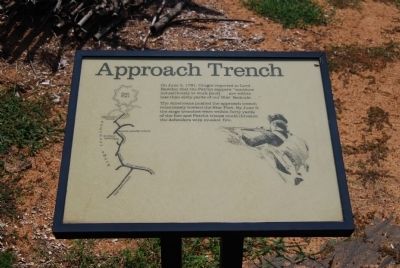
Photographed By Brian Scott, September 5, 2008
3. Original Approach Trench Marker
On June 3, 1781, Cruger reported to Lord Rawdon that the Patriot sappers "continue industriously at work [and]...are within less than sixty yards of our Star Redoubt..."
The Americans pushed the approach trench relentlessly toward the Star Fort. By June 9, the siege trenches were within forty yards of the fort and Patriot troops could threaten the defenders with musket fire.
The Americans pushed the approach trench relentlessly toward the Star Fort. By June 9, the siege trenches were within forty yards of the fort and Patriot troops could threaten the defenders with musket fire.
Credits. This page was last revised on March 4, 2022. It was originally submitted on September 8, 2008, by Brian Scott of Anderson, South Carolina. This page has been viewed 932 times since then and 18 times this year. Last updated on October 30, 2018, by Bruce Guthrie of Silver Spring, Maryland. Photos: 1, 2. submitted on July 12, 2010, by Brian Scott of Anderson, South Carolina. 3. submitted on September 8, 2008, by Brian Scott of Anderson, South Carolina. 4. submitted on July 12, 2010, by Brian Scott of Anderson, South Carolina. 5, 6. submitted on September 8, 2008, by Brian Scott of Anderson, South Carolina. • Andrew Ruppenstein was the editor who published this page.
